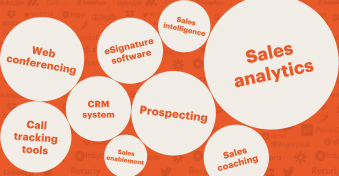Creating new sales opportunities and achieving stable growth is the goal of every company. Precision prospecting is the first step toward reaching new revenue heights.
Prospecting is the process of searching for potential buyers (the prospects) that are good fits for your service or product and then communicating with them in a way that moves them to the next stage of a sales pipeline.
The goal of prospecting is to convert leads (contacts) into prospects (potential buyers) into clients.
Most high-performing sales development representatives (SDRs) describe sales prospecting as equal parts of artform and science.
However, with all the myths going around and SDRs using outdated methods, many feel prospecting is their #1 pain point. Can you make outbound prospecting a fun and fruitful process? With these proven techniques, yes you can.
01. Be relentless
Prospecting should be your top priority. And it must be your top priority all the time.
“It takes 18 dials to connect with a buyer and only 23.9% of sales emails are opened.”
According to TOPO
It takes time to convert a prospect into a buyer, but it takes even more time to connect with a prospect.
To make this process consistent, you should spare a block of time in an everyday schedule of an SDR that would be dedicated to prospecting. Set goals and track results and this routine will pay off.
02. Create referral programs
Referrals can be neglected by a modern salesperson.
Only 30% of B2B companies have a formal referral program in place, yet 65% of those with referral programs believe that referrals are very important to their company’s sales success.
Why are they so important? Because 73% of B2B executives prefer to work with sales professionals who have been referred to them by someone they know and trust.
Also, referred prospects move through the sales pipeline faster because they are more likely to trust the praises sung by your clients who they already have a relationship with.
Why create referral programs? To make it easier for your business development efforts, accelerate your pipeline, and make your clients feel like partners.
03. Warm-up cold leads
Whether you are cold calling or cold emailing in 2020, you must know these outreach channels should not feel cold.
If you have an opportunity to make it warmer through referrals and mutual connections, do it.
And if you are active on social media, your blog, or have ads to help you out – your first touch isn’t cold anymore. Your name is in front of some prospects’ eyes, your emails get opened more often, and the positive engagement from calls increases.
To add a human touch to your prospecting, you should consider implementing a personalized approach every step of the way.
The right Customer Relationship Management (CRM) software can help you automate personalization at scale. For instance, personalization in email marketing campaigns turns cold emails into warm ones.
It makes an email feel individually crafted, which differs from the bulk-emails prospects are used to.
04. Develop a relationship
This prospecting technique takes a lot of time and effort but is totally worth it. Nowadays, reaching your prospects is all about customer experience.
It can be as easy as a “you” message instead of a “me” message. To achieve that, you have to craft opportunities to begin building positive relationships at the first interaction with your potential buyers. After all, you only get one chance to make a good first impression.
Start with personalization. 77% of consumers have chosen, recommended, or paid more for a brand that provides a personalized service or experience.
Look through a prospect’s blog, social media profile, or website. Address their needs and base your value on existing industry pain points. When a prospect feels that your aim is to help before you sell, you gain trust.
A good rule of thumb: use the emotion of trust to overcome objection in the B2B world.
05. Show your expertise
How do you prove to your prospects that you can deliver on your brand promise? Establish your company as a thought leader in your industry and space.
There are a few ways to let your prospects associate your brand with trust and proof of concept:
1. Blog
Blogs dedicated to a business specialization, industry problems, and innovations infused with your company’s experience is the best way to show your expertise. Make sure you contribute guest articles as well.
2. Q&A forums
Sources like Quora, Reddit, or ProductHunt give you an opportunity to show your knowledge by practice. A person that has asked you a question and got an expert answer can easily turn into a prospect of yours.
3. Social media
Each prospect has a favorite way of consuming information. Social media is a very important resource, don’t underestimate it.
At least 75% of B2B buyers use social media to support their purchase decision. Be active on Twitter, Facebook, and LinkedIn.
4. Awards and recognition
Having your work recognized by top industry leaders, magazines, or award programs is a great achievement for your business.
It gives a boost of credibility in the eyes of your potential customer, and it helps you stand out from other vendors. Make sure you share your victories with prospects: via social media or a separate tab on your website.
5. Review sites
Just like referrals, reviews have a tremendous influence on buying decisions.
“7 out of 10 buyers will reference reviews in the consideration phase. Opinions of your customers matter to prospects. Choose a review-platform that is used by your target buyers and ask all of your clients to leave reviews there.”
According to the G2 2018 Report
06. Check-in with former customers
Customers may stop using your service, but not all of them feel you’ve failed. Natural churns occur from time to time and that’s alright.
It could’ve happened because of the budget cuts, operational or staff change, or they feel they no longer need your service.
If these former customers had great experiences but churned because of outside factors, there’s an opportunity to re-convert these old customers into returning clients.
These customers know your service and whether you are good at it. Send informational emails with news or updates from time to time, communicate on social media, and congratulate them on some new achievements.
A friendly gesture goes a long way. Think of it as purposeful lead nurturing, but for people that know you well.
After checking in on how they’re doing along the lines of your services or product, it’s a good idea to see if they’re ready to renew talks.
07. Event prospecting
Obviously, with the pandemic disrupting the world, events have been canceled en masse. Yet, as soon as industry events get back on track, we suggest you use them as one of your prospecting techniques.
First, you have to get a picture of which attendees of relevant events match your Ideal Customer Profile. Second, check what is the purpose of this event. Based on this insight, you can start pre-event prospecting.
Check the guest list and decide what conversations these prospects would be most open to having. Event attendance is a slam-dunk personalization for an outbound email campaign.
Speaking at the event is a marvelous opportunity to present your company and position yourself as a thought leader, but also be sure to use networking breaks to meet your potential customers.
Meeting them in person is a great boost for your prospecting efforts.
Bonus prospecting tips
- Always follow up. 70% of SDRs give up after the first email even though it takes 10+ touches to secure a meeting on average. Don’t lose an opportunity to close the deal.
- Be helpful; don’t sell. Your goal is to start a conversation and build a relationship. Let your sales execs sell on the next stage of the sales cycle.
- Use a multichannel outreach strategy. From email and phone to social media and ads, each channel gives you the opportunity to build brand familiarity and positive prospect experiences.
- Use automation software. Prospecting involves a lot of time-consuming tasks that can be handled by automation software. It will save time which your SDRs can use to actually prospect.
The goal of prospecting is to develop meaningful relationships with your prospects that will result in long-term cooperation, resulting in better growth outcomes.
It is a continuous and complicated process, but these prospecting techniques will help you navigate the sales development waters and build predictable top-of-funnel action.


